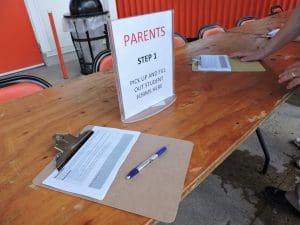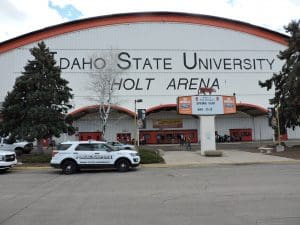Editor’s Note: Although this article was originally posted in Nov. 2019, we are rerunning it due to the topic’s current relevance. As we grapple with the devastating massacre at Robb Elementary School in Uvalde, Texas, which took the lives of 19 children and two teachers, it’s clear that schools and districts must have parent/student reunification plans in place.
Active shooter response and training now dominate the K-12 school safety and security discussion. Most of these trainings end with a statement that goes something like this: “The school will reunite students with their parents.” However, the operational implications of this simple statement are enormous and have historically proven overwhelming.
Active shooter response, regardless of the protocol, is immediate, specific and short-term. This lends itself well to the exercise process, much like the monthly evacuation exercise (fire drill). Reunification, arguably the first step in the recovery process, is exactly the opposite. It is complex and will be protracted. Additionally, reunification exercises are generally major endeavors and require significant amounts of planning, resources and orchestration, which makes exercise opportunities rare. How schools can develop capacity is always the question.

The best practices summarized in this article were developed by the Bannock County Emergency Manager and Idaho Office of Emergency Management when they conducted a full-scale school relocation/reunification exercise.
It would be well to remember that not all or even most school reunifications are precipitated by a school shooting. Most educators, over the course of their careers, will not be involved in a school shooting. That said, nearly all educators will be required to return students to their parents following some event that is different than the normal end-of-day process. Any number of issues, from a power outage or gas leak to severe weather may require a school closure. These events can and should be used as exercise opportunities to develop capacity.
In any case of abnormal cancellation of classes, regardless of cause, there will be a need for an organized process to reunite students and parents, assuring that the right student is returned to the right parent (or guardian) and provide for record keeping with positive accountability. In true multi-hazard fashion, the procedures used should, to the greatest extent possible, mirror your reunification procedure. This approach assures that on that worst of all possible days, the experience gained over the course of time will give educators an operational basis to rely on.
Idaho Community Conducts a Relocation/Reunification Exercise
I recently had the opportunity — working with the Bannock County Emergency Manager and members of Idaho’s Office of Emergency Management — to serve as an evaluator for a full-scale school relocation/reunification exercise. The exercise was held in Pocatello, Idaho. The reunification portion was part of a much larger critical incident/active shooter and mass causalities scenario. The subject school, once evacuated, served as the site of full-scale active shooter training for police, fire and EMS. Simulated victims were transported by ambulance and police vehicles. The local hospital, Portneuf Medical Center, a level II Trauma facility, exercised their mass causalities protocol with the arriving role players from the school site.
To set the stage, Pocatello is the county seat and largest city (approximate population of 56,000) of Bannock County in the southeastern part of Idaho. It is the principal city of the Pocatello metropolitan area (approximate population of 86,000). Pocatello is home to Idaho State University, Public School District No. 25 and nine other K-12 private or public charter schools. The metropolitan area is served by three distinct law enforcement jurisdictions, as well as multiple fire and EMS agencies.
The Pocatello Police Department (PPD) has been highly proactive, consulting with schools to improve security and delivering active shooter training to their K-12 school administration and staff under the Civilian Response to Active Shooter Events (CRASE) model. The genesis of the reunification exercise was a discussion in the early fall between the PPD school resource officer (SRO) cadre and the administration of a private parochial school, Grace Lutheran.
The school has just under 300 K-12 students. The school’s population size and grade make-up proved to be ideal as an initial test case for a relocation and reunification exercise. The school administration and community were concerned, willing and engaged in school safety and security issues. The wider Pocatello K-12 school community, particularly School District 25, became equally engaged and agreed to provide manpower and resources.
How the Full-Scale Exercise Was Planned
A planning team was identified and assembled, and the process began. Research of historical school shooting incidents early in the planning process helped to develop some of the planning assumptions:
- There was a need for a written operational guide.
- A basic familiarity with the process would be required for everyone involved.
- A reunification facility needed to be pre-identified.
- Following any critical incident, the traumatized staff of a school would be incapable of providing sufficient manpower for a reunification process unassisted.
The “I love U Guys” standard reunification protocol was adopted and then modified to serve as the operational guide. Partnering with Idaho State University’s (ISU) Public Safety Department, the Holt Arena, a sports venue, was chosen as the reunification center.
The planning team in consultation with local school administrations determined that a community-based effort would best serve all the K-12 schools in the area. Personnel from several of the school organizations. as well as volunteers from partner agencies. were contacted and agreed to participate. The exercise director, PPD SRO Zac Bartschi contacted the South Eastern Idaho District Health and requested that their public health preparedness team act as the incident command system overhead team for the exercise.
Training meetings were scheduled and the exercise date was set. A multi-agency group of more than 50 volunteers attended the training meetings, and over 35 were on hand at ISU’s Holt Arena the day of the exercise.
Reunification Lessons Learned
As with all exercises, much of the benefit is in the lessons learned. Understanding that other schools, agencies and communities can benefit from their experience, all of the partners involved have agreed to share some of the lessons learned in this exercise.
- Plan Your Resources The planning process to identify, procure and orchestrate the use of multiple organizations’ resources to meet the goals of the exercise clearly identified what would be needed in the case of an actual relocation/reunification event. In the artificiality of the exercise environment, all the partners knew and agreed to the role they would play, the resources they would provide, and the time and place they would be needed. All of this contributed to a highly successful exercise.

The Idaho State University Public Safety Department helped with the exercise. ISU’s Holt Arena was chosen as the reunification center.
- Develop Memorandum of Understanding Among Partners To assure this same capacity in the case of an actual event, developing a formalized written agreement or a memorandum of understanding (MOU) among all the partners becomes a necessity. The MOU should identify the agencies involved, the resource being offered or requested, and the process to activate use of the resource. Be sure to address any financial considerations associated with the use of the resource. Last, as a part of the MOU, provide an annual review process with the agreements. This step will be critical to assuring ongoing operational capacity.
- Develop an Interoperable Communications Plan Effective communications were critical to successful reunification operations. The planning team, understanding that communications are a common fail point, utilized an interoperable communications plan already in place for community incidents to connect all the agencies involved. Such a process should be a foundational element of reunification planning.
- Adopt the Incident Command System Use of the Incident Command System (ICS) was a notable factor in the exercise’s success. ICS protocol was used to manage the event, including a unified command group at the reunification center with PPD, Grace Lutheran Schools and the reunification overhead team represented within the unified command group. The exercise director and lead PPD officer over the reunification aspect of the exercise in conjunction with the school administration empowered the reunification overhead team to make command decisions about reunification center operations. The use of an ICS-trained overhead team freed the school staff to focus on student support and effective, verifiable reunion of students with their parent.
- Pre-incident Development of Tools Worked The reunification leadership team used the tools available via the “I Love You Guys” Foundation standard reunification documentation to develop a reunification “kit.” Housed in three plastic tubs for ease of mobility, the kit included colored vests for identification, binders with directions for command staff, general staff and branch supervisors. These binders included job action sheets and name badges for all members of the reunification team. This kit arrived at the reunification center with the overhead team and provided the organizational basis for arriving volunteers.
- The Manpower Required for Reunification Is Deceptive With approximately 300 students involved, there were 35 volunteers assigned exclusively to reunification activities. Time for a parent to be processed through from arrival at the center to leaving with their student was between 17 and 23 minutes. The artificiality of the exercise environment assured that parents were calmer and more compliant while waiting for their student. A larger student population could have significantly increased the processing time. The limiting factor in the process is the number of requests that were processed simultaneously.
- Exercise Didn’t Cover All Aspects of Accountability Accountability for all students in a school at the time of the event and continuing through to the point the student is returned to the parent is the primary consideration for any school staff. Here, the artificiality of the exercise environment did not provide for some of the more problematic elements of student accountability. A process for self-evacuated students to report and for injuries and deaths to be communicated from all venues to the reunification center should be developed. These are critical elements that were not part of the exercise design but will be essential in the success of an actual reunification process.
Some Final Thoughts
This is simply a brief overview of some of the findings from the after-action report. The full FEMA HCEEP report is available to schools and first responder agencies upon request.
Should it be required, the reunification of students with their parents following an active shooter event will be one of the most complex and involved responsibilities school staff members may ever face. An effective, well-executed reunification process is the critical first step in recovery for both a school and the community. A poorly executed reunification will adversely affect your school and community and slow the recovery process.
With that understanding, schools, first responding agencies and communities should collaborate to develop a reunification process tailored to the needs and resources available to them. Schools should look for the opportunities to practice the elements of reunification as a part of the more predictable events that require returning students to their parents outside of a normal release.
It’s like an insurance policy, available and ready to address the accident, but with the hope it will never be needed.
Guy Bliesner is a School Security Analyst for the Idaho Office of School Safety and Security. To obtain the full FEMA HCEEP report, contact Guy at [email protected].






